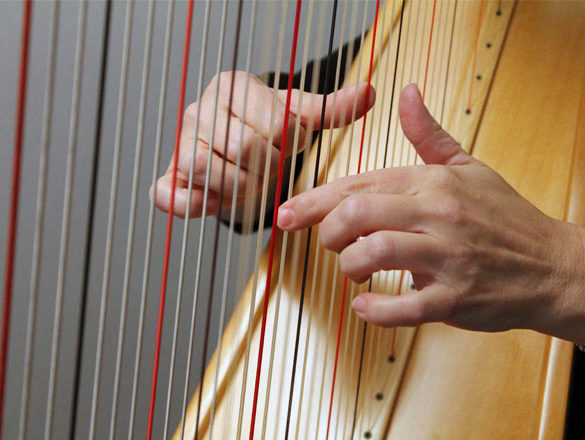From our tablet issue: Senses

Nan Noble can remember the first time she played the harp in public. She sat on her cushioned chair, placed her fingers on the metal wires and played. Twenty-one years ago, she sat on her stool to the side of a casket. Solemnly, Noble rested the maple wood against her clavicle and placed her fingertips to the wire strings of a 92-pound harp.
In August 1991, before her sister’s, father-in-law died, he told Noble he wanted to hear her play, but she didn’t feel ready. Without hearing her music, he knew he wanted her to play at his funeral, when the time came.
“I said, if he could hang on six months, then I’d feel more comfortable playing for him,” Noble says.
Her father-in-law died in October, two months shy of Noble’s request and only two months after she started playing the harp. Because Noble did not own a harp, the funeral home borrowed an older, colorless one from Indiana State, Noble’s alma mater. She was allowed to color the strings with a Sharpie, to label the six different octaves.
Noble said she took a deep breath and rested her fingertips against the wires.
“I thought I would just be background music while they were having the visitation, so I sat down and I started to play. I was just shaking because I never played in front of anyone,” she says. “As soon as I started playing, everyone sat down. I was scared to death and just shaking the whole time. Finally, I thought, just pretend like it’s nothing big. I took a couple of deep breaths and relaxed.”
Noble not only received an offer to play for the funeral home, but also has participated in Elizabeth Richter’s Muncie harp ensemble for 21 years, at funerals, weddings, receptions or churches. Noble says her favorite place to play is the annual Minnetrista Luminary Walk.
Although she didn’t start playing until she was 33 years old, Noble’s first memory of wanting to learn to play comes from her childhood home in Nevada.
“There was this divider in our home between the kitchen and the living room that was just string. I would run my fingers along that and always pretend I was playing,” she says.
When her family moved to Terre Haute, Indiana, Noble and her family attended any concert that included harps. She frequented performances while attending college, too. When she married and moved to Muncie, she went to all of the performances by Elizabeth Richter, a professor of music performance at Ball State.
After seeing a few of her concerts, she finally asked Richter to give her lessons. Noble bought a harp and took lessons for three years, practicing three hours a day or, “whenever my kids would not require attention.”
“I loved practicing. Elizabeth was an excellent teacher,” Noble says. “She worked a lot on technique. She would assign a lot of exercises. And working hard on the exercises really gets your fingers [tough].”
During the Luminary Walk at Minnetrista, Noble played for three hours straight, without taking any breaks, despite Elizabeth’s warning.
“[Elizabeth] told me that was too long to play,” said Noble. “But people were always so interested in the harp itself, so I seldom took breaks. I knew my fingers would be calloused, but I felt like my audience deserved a show.”
She began playing at the Luminary Walk before the event was free. Attendees paid $5 per person or $10 per family to see the glistening Christmas lights, ride sleigh rides or hear the musicians blow into their instruments, tap their fingers along strings, or beat a soundboard. When Minnetrista made it free for the community, Noble said her job became even more exciting.
“There are families that have come for almost 15 years. Every year you see the kids get older,” she says. “I get so much satisfaction, especially with little kids. They sit there and they just stare and the look on their faces is just so rewarding.”
Some of her favorite harp-playing memories include witnessing countless engagements, seeing little girls dancing to the harp and those who will just sit and listen for a while.
“It’s just one way I know I can give back to people. I know I’m going to have blisters by the end of two nights, but I feel like I’m robbing them if they come and I stand to take a break,” she says.
Noble also takes her harp to Storer Elementary and Mitchell Elementary Schools, where she teaches elementary music.
“I used to wish I could clone myself, so I could have one person who concentrated on [playing] the harp and one person who taught,” Noble says. “I just want to keep playing.”




